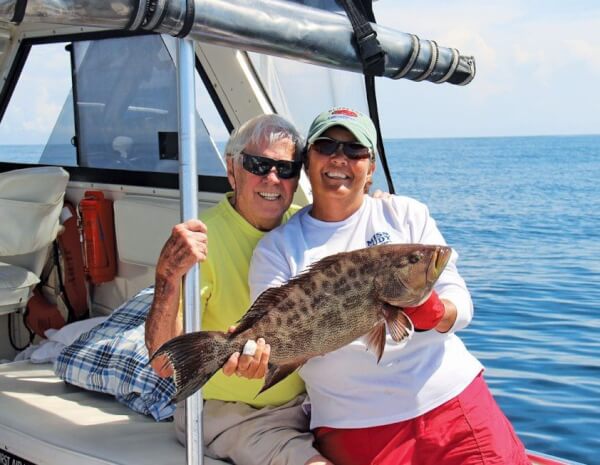
INSHORE
Though the temperatures are still hot, the shorter days alert fish that fall patterns are pending. Fish are not migrating this month, rather they are feeding on everything that is available. Spotted seatrout, redfish, and flounder might feed at different times of the tides, however, they all like live shrimp. You can serve the shrimp up any way you like from naked with or without any sort of leader or weight, to under popping or adjustable floats.
The secret to the fish’s bite in September is, once you get the bite going, it’s easy to change your bait. For instance, if you start using live shrimp and they all happen to die or you run out, your best bet then is to change over to any leftover parts from previous hits and/or start using DOA shrimp patterns. The “old school” DOA shrimp patterns work like a charm. Here’s a tip: when using pre-rigged DOAs, meaning when they are purchased with hook and balance weight, I suggest removing weight and hook. Then take a 2/0 to 3/0 Kahle hook and hook the shrimp up like you do the live shrimp. Place the hook in the mid-ship of the shrimp to make the DOA look as natural as possible. Once it’s balanced on the hook’s bend it then becomes the perfect waving bait in the current under a popping cork or an adjustable float. The best colors are root beer, clear gold glitter, clear chartreuse tail, white, and golden cherry red. I suggest using three inch DOA shrimp patterns. Another secret — drop a few artificial DOA’s into your live well to add “juice appeal” to your bait.
OFFSHORE
Offshore fisherman consider September “snag a gag” month! The grouper bite is better because things are cooling down, causing more movement. Gags, scamps, and red groupers are more likely to be up and about. The best places to look for these fish are the live bottom ledges at the Savannah Snapper Banks. The best nervous (seemingly bladder-less) baits are going to be live cigar minnows and Spanish sardines, which can be caught with Sabiki gold hook rigs. You can find these surface-schooling over the structure at artificial reefs. These baits are known for triggering a serious, on-the-spot grouper bite, however bigger fish sometimes want bigger bait. Baits caught at the banks are normally those fish that have air bladders such as sand perch, rock bass, vermilion snapper, pinfish, and ruby red lips. Before putting baits in live well, I suggest deflating the air bladder with sharp-pointed knife.
For larger bottom fish I consider the sand perch the best bait because it seeks safety in the sand not the structure. A larger grouper will leave the protection of the ledge with hopes of an easy meal, placing itself too far from the safety of its habitat, allowing you a better chance of landing your fish. When a sand perch settles down on a sandy bottom it creates a sand storm, which catches the keen eyes of a grouper. However, on some days if the bottom visibility is not clear, the bigger fish won’t see the sand perch.
Then there are baits, such as the rock bass, that prefer the safety of the structure. The best roaming baits that like to suspend up in the one to five-foot range around the structure are vermilion snapper, scup, pinfish, and ruby red lips.
As far as the top water bite for Spanish and king mackerel, I suggest giving Savannah River Channel, (also known as Tybee Roads), artificial reefs, and the Savannah Snapper Banks a try. Blue runners, Spanish sardines, pinfish and Spanish mackerel, are best for targeting the king mackerel. The Spanish mackerel should have arrived in full force and can be caught trolling 0 to 00 Clark spoons in the sounds, off the beachfronts, and around the nearshore artificial reefs located less than 60 feet of water. Look to the sky for any diving seabirds. Our fine feathered friends with their keen eyesight are known for showing us the way.
During September it’s not unusual to catch dolphin, also known as mahi mahi, while bottom fishing. Dolphins are curious fish and they will swim right to the boat. To get their attention I suggest throwing out a few small pieces of bait. If bottom fishing, remove your weight off the rig, loosen your drag, and float your bait (squid or cut fish) right to the circling mahi mahi. A small jig, live bait imitating lure, or live cigar minnow will also get their attention. Spraying your wash-down up in the air, allowing the sprinkles to hit the surface, creates a fake live bait frenzy. Once the fish realize it’s only for show, they will be gone; however, spraying along with casting cut bait overboard helps keeps their attention. Once the dolphin turns on its feeding lights it will suck this bait in just like most of us do when chocolate is involved! If there is more than one mahi mahi, leave the last fish caught in the water until the next fish is hooked up!





